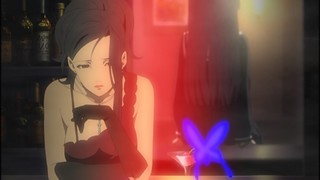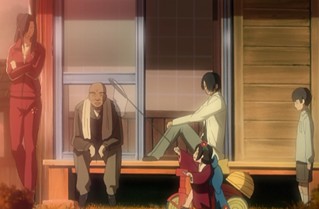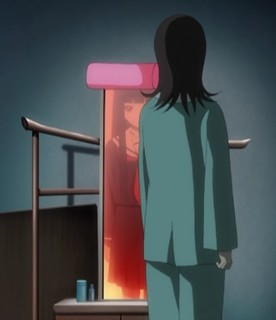If there’s one thing the Hell Girl series knows how to do, it’s mess with a formula. For those unfamiliar with how Hell Girl operates, this is the gist: a person who feels legitimately tortured contacts Hell Correspondence via a website only available at midnight. Hell Girl, Ai Enma, appears and offers a pact: immediate retribution, in the form of an idiosyncratic induction into the infinite inferno, in exchange for the condemner’s soul after he or she dies during the course of his or her natural life. Those doing the damning don’t have to be in the right to feel tortured, they just have to have a certain degree of emotional desperation.
In the first season, those who do the condemning are victims and therefore the good guys, while those who cause the condemnation are the instigators and therefore bad guys, and Ai Enma and her team are more or less a supernatural vigilante justice squad. In season two (check out my reviews of Part 1 and Part 2), those who condemn range from mildly justified to malevolent and shallow. Those at the end of their accusers’ pointed fingers are the usually shown in a victim’s light, and Ai et al. find themselves beaten down by an abhorrent duty to which they’re bound despite circumstance. The third season of Hell Girl (Three Vessels) strikes a precarious balance between both hell-bound parties and makes a drastic jump with its avatar.
Until now, Ai, when summoned via the Hell Correspondence website, would materialize behind the accuser’s shoulder, appear in some reflective surface, or transport the tortured soul to the blood-stained shores of her own realm in order to make the requisite pact. At the end of season two, however, Ai is stripped of her physical form for an act of defiance. So season three finds Ai requiring a new body before she can return to her duties; enter, Yuzuki Mikage … literally. While innocently looking to Calgon away her worries regarding an antagonistic teacher, Mikage finds herself drifting a bit off course in the warmer bathwaters of what she convinces herself is a yuri-themed dream. The kiss that transpires betwixt Ai and Mikage consigns the latter to be the former’s vessel whenever underworldly duties call, and the transition is nothing short of genre-bending:
A magical girl transformation, Hell Girl style! And best of all, it’s relevant! Because Mikage is far too innocent to cope with Ai’s duties, Mikage is thrust behind her own eyes whilst alter ego Ai takes over. During the transformation, Mikage’s body painfully morphs into the cocoon for Ai’s gestation and subsequent emersion which shatters said womb. While this imagery may seem out-of-left-field-ish, it’s actually right in line with how Ai originally comes back to this world: in the form of a blue butterfly (a glowing image of which is shown on Mikage’s back during the change). The swapping of bodies can be likened to a more grotesque take on swapping of casual clothes to sailor uniforms and the like; what was Mikage in her school clothes becomes Ai Enma in trademark black kimono. She who is but a casual observer now becomes a force for change. The Hell Girl twist is not actually all the slight tweaks to the magical girl formula, as mentioned above, but the involuntary nature of each transformation, the agony portrayed therein, and the helpless, tortured sense of captivity felt by Mikage. These aspects are not homages, they are Jigoku Shoujo making Mahou Shojou its own.
in the form of a blue butterfly (a glowing image of which is shown on Mikage’s back during the change). The swapping of bodies can be likened to a more grotesque take on swapping of casual clothes to sailor uniforms and the like; what was Mikage in her school clothes becomes Ai Enma in trademark black kimono. She who is but a casual observer now becomes a force for change. The Hell Girl twist is not actually all the slight tweaks to the magical girl formula, as mentioned above, but the involuntary nature of each transformation, the agony portrayed therein, and the helpless, tortured sense of captivity felt by Mikage. These aspects are not homages, they are Jigoku Shoujo making Mahou Shojou its own.
Season 2 and Season 3 of Hell Girl are currently streaming on Crunchyroll.com.
Snapshots is a monthly column in which one of our writers reflects upon a particular moment from an anime, manga, or video game. New entries are posted on or around the 15th of each month. To read previous entries, click here.



